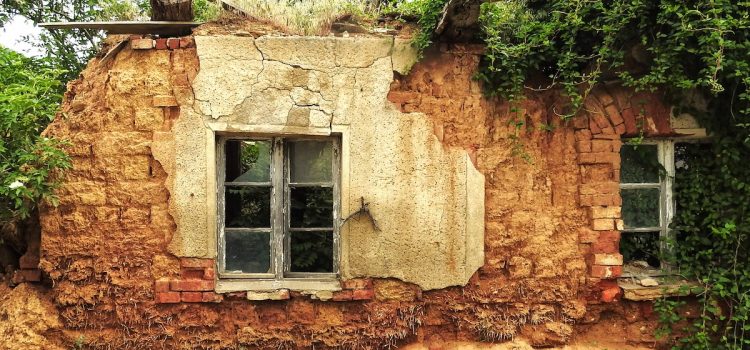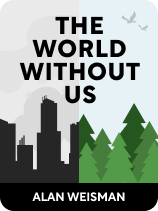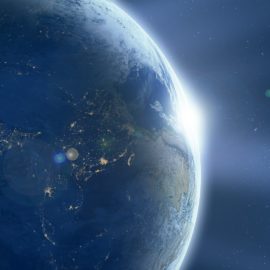

This article is an excerpt from the Shortform book guide to "The World Without Us" by Alan Weisman. Shortform has the world's best summaries and analyses of books you should be reading.
Like this article? Sign up for a free trial here.
What effects, positive or negative, would the disappearance of humans have on the world? How permanent are the changes we’ve made?
The human race has left a mark on our planet. In The World Without Us, science journalist Alan Weisman asks what would happen if the human race vanished overnight. Weisman’s goal is to address humanity’s environmental impact by imagining a world in which nature is allowed to flourish.
Keep reading to learn how the Earth after humans would be significantly different than what came before.
The Earth After Humans
Given all the ways in which we’ve reshaped the world and continue to affect it every day, Weisman asks a question that’s normally the purview of science fiction writers: What if the human race vanished all at once, but left all our buildings, roads, and power plants intact? What would the Earth after humans be like? We’ll explore Weisman’s answers chronologically, first looking at the immediate effects of humanity’s sudden disappearance, then progressing through the first decades and centuries as the world adjusts to our absence, before finally imagining how the Earth might be thousands of years after we’re gone.
Immediate Effects
The first thing that would happen if we disappear is that every system requiring human maintenance would begin to break down. Depending on the system, the effects would be seen in minutes, days, or years, and though some of the results would be beneficial for nature, others would be disastrous. Weisman describes the initial consequences of the absence of human control over our cities, industrial equipment, and power plants.
In our imaginary scenario, the natural world would quickly reclaim every manmade structure. Without repair, water would leak into houses, causing mold and rust that would further weaken their structure. In winter, water pipes would burst, adding to the damage, and as our buildings crumble, plants and animals would find their way inside. Citing the modern example of Cyprus, where towns and resorts were abandoned due to war, Weisman says that within a handful of years, roofs will have collapsed, trees will grow in houses, and small animals such as birds and rats will have fully turned our homes into theirs. As our houses decay, they become a fire risk, and blazes sparked by lightning may run rampant through our cities, leaving only stone and metal behind.
(Shortform note: In addition to examples Weisman singles out, the world is replete with abandoned towns and cities, many of which now serve as tourist attractions in various levels of decay. One of the most recent is the island village of Houtouwan, China, whose last residents moved elsewhere in the 1990s. After only a few decades, the village is now completely covered by plant life. Ancient lost cities can be hidden so well that they can only be distinguished from the natural landscape using advanced imaging technology such as Lidar. In The Lost City of the Monkey God, Douglas Preston details explorer Doug Elkins’s efforts to use such technology to uncover the fabled Ciudad Blanca which had been totally obscured by the jungles of Honduras.)
Weisman points out that, immediately upon the disappearance of our species, every piece of technology that requires human operation would cease to function, and those that require constant supervision would soon grind to a halt. Subways in coastal cities would flood without humans to maintain the water pumps that keep them dry. Water would also seep into buildings with no one around to patch roofs and windows. Roads will crack and form potholes, and with no one to repair them, plants will take root and accelerate their natural decay. With no one to maintain them, dams will burst and overflow, turning artificial reservoirs back into valleys.
(Shortform note: Even with human intervention, maintaining infrastructure in the face of nature’s power is an ongoing struggle. In 2019, the US Army Corps of Engineers labeled California’s Mojave River Dam as a high failure risk in the event of storms and flooding. A study released in 2021 showed that melting permafrost is quickly degrading Alaska’s roads and threatening access to isolated communities. Even with massive new investments, such as the US’s $1 trillion bipartisan infrastructure bill, crumbling roads and water management systems are difficult to repair due to rising costs and decades of neglect. Should Weisman’s scenario come to pass, nature will already have a head start on demolishing what we leave behind.)
But all would not be well for the natural world. Weisman explains how a disaster would come as our untended chemical and petroleum plants fail in a variety of ways. Though above-ground chemical storage containers are designed with a 20-year lifespan, without humans to perform upkeep on pressure valves and safety systems, the volatile chemicals and stored liquid fuels may leak into the soil as their holding tanks corrode. Before then, if the tanks’ grounding lines rust, lightning strikes would ignite chemical fires that may cascade into explosive chain reactions, releasing clouds of toxic gas into the atmosphere. Such chemical disasters all around the world would kill many plant and animal species while mimicking some effects of a “nuclear winter.”
(Shortform note: A nuclear winter is the hypothetical “mini ice age” that would follow in the wake of a nuclear war. After the initial heatwave from hundreds of atomic blasts, the smoke, ash, and dust from the resulting fires would blanket the upper atmosphere, reflecting much of the sun’s light back into space and dropping global temperatures by as much as 20 degrees Celsius. The possibility of a nuclear winter was made public by Carl Sagan in 1983 but remains relevant amid fears of a renewed conflict between the US and Russia in the 21st century. In addition to the sudden climate impact, a chief danger brought about in such a scenario is widespread famine caused by the death of many crops.)
As for our nuclear legacy, the more than 400 nuclear plants in the world would wreak havoc across wide ranges of the environment. Weisman writes that in the absence of human oversight, the cooling ponds housing used nuclear fuel rods would boil off, igniting radioactive fires. The system of pressure valves within the plants themselves will inevitably break down, triggering meltdowns all across the world. Meltdowns result in steam explosions—not nuclear explosions—but which nevertheless eject radioactive smoke and ash to be carried by the wind across wide swaths of land. The radioactive slag within the reactors would eventually cool, but would still be deadly for thousands of years.
(Shortform note: In Weisman’s thought experiment, no one is around to shut down nuclear reactors properly. In more ideal conditions, a nuclear plant’s fission reaction can be brought to a halt using neutron-absorbing control rods. This shut-down process is triggered automatically when sensors detect abnormal temperatures or pressures. Given enough time, a nuclear plant can be safely decommissioned, though doing so is expensive and can take decades.)
Nature Strikes Back
Despite the initial negative impact humanity’s absence would have on the world, the forces of nature would steadily recoup their losses. Given time, the natural world will erase the relics of our civilization, though the new status quo would be different than before because of human intervention. Forests would reclaim land that was cleared for human use, and wildlife would flourish in our absence, as evidenced by places in the world where humans have already disappeared. One example is New England, where Weisman notes that the forests returned to land once cleared by American settlers. Today, it takes a trained botanist’s eye to see where new growth covers farms from centuries past.
(Shortform note: Thanks to clear-cutting for agriculture and timber, only a quarter of New England’s forests remained intact at the end of the 19th century. Once those practices ended in the region, a mix of fast-growing hardwood trees began to spread across once-open farmland. Active conservation efforts took root in the middle of the 20th century, and today over a million acres of forest are protected in New England and neighboring New Brunswick in Canada.)
If humans disappeared altogether, forests across the world would bounce back in similar ways, especially in Africa and South America. Without humans adding fertilizer to soil (and its runoff), the dead zones at the mouths of rivers like the Mississippi would once again flourish. The same would be true for coral reefs once humans stop damaging the oceanic balance.
(Shortform note: There are several factors necessary for an ecosystem to return to its pre-human state. The first are legacy species native to an environment that either survive the damage done to the ecosystem or are reintroduced. Next are mobile link organisms that cross the boundaries between ecosystems, spreading pollen and seeds and promoting biodiversity. Third are habitat areas for those mobile links, preferably adjacent to the ecosystem in recovery. Environmental management can facilitate recovery, but traditional wilderness management techniques tend to produce ecosystems with less biodiversity than those occurring naturally.)
The Ecosystem After Us
Within two or three centuries, the world’s new ecosystem would thrive, though it would comprise a mix of species that never would have met without being transplanted by human colonization.
(Shortform note: While humans have been transporting species away from their native habitats throughout history, the degree to which we’ve done so accelerated dramatically once permanent contact was established between the eastern and western hemispheres. In 1493, Charles C. Mann describes the full extent of the “Columbian Exchange,” the widespread rearrangement of flora, fauna, and human cultures during the age of European exploration. Many plants and animals that we associate with certain parts of the world—potatoes in Ireland, tomatoes in Italy, peppers in southeast Asia, and horses in the American West—are all transplants resulting from the colonization and trade of goods brought about by recent human migration.)
The same holds true for the animal kingdom, where many species would grow in number as their native habitats return. While they stand, our bridges will act as highways for wildlife across rivers and into such cities as Manhattan. Species that depend on humans would suffer, such as domesticated dogs and cattle, as well as rats and roaches that have adapted to live on our garbage. Cats, on the other hand, would thrive as predators in the many parts of the world where we’ve brought them. Larger carnivores would make a banquet out of our livestock—species that humans have bred for food would die out in a matter of centuries. Birds would once again spread across the skies, and chimpanzees might replace us as the apex primate.
(Shortform note: Biological adaptation is an ongoing process, and the ecosystem of today is merely one snapshot in the developmental line. Like Weisman, many scientists like to speculate about what directions life might take in the future. Surviving species may fill niches vacated by others that go extinct, and some may change habitats completely, adapting to climates their ancestors would have found hostile. In Hurricane Lizards and Plastic Squid, biologist Thor Hanson observes that some species are already adapting to climate change, such as tropical reptiles that are breeding to withstand harsher weather and butterflies evolving stronger wing muscles to fly farther and find new territory as humans crowd out their old habitats.)
Weisman writes that we’ve already seen the resilience and power of nature to reassert itself in the absence of humanity. One such place is in Central America, where the jungle has almost completely obscured the remains of the Maya civilization. The Maya’s great cities and pyramids are now easily mistaken for natural hills.
(Shortform note: One such place is the Mayan city of Chichen Itza in Mexico’s Yucatan region. Chichen Itza was abandoned in the 13th century. And, by the time the Spanish arrived 300 years later, it had already been reclaimed by the jungle. Though part of the city has been cleared and restored as a UNESCO World Heritage Site, archaeologists continue to discover new parts of the city hidden in the surrounding wilderness.)
Modern architecture would fare worse than that of our ancient forebears. Materials such as wood, concrete, and metal are far more susceptible to decay than the stoneworks of the ancient world. Even places that have been rendered toxic, such as the region surrounding Chernobyl, have been overrun by plants and wildlife, making it their home despite shortened life spans due to the radiation present.
(Shortform note: Natural resilience of the type Weisman describes has been a study of evolutionary biology since the 1960s. Scientists observe that successful species adapt to changing conditions by rapid reproduction, specialization, or a combination of the two. Meanwhile, conservationists have had success restoring habitats and protecting species by increasing the size of nature preserves and dismantling harmful human infrastructure, such as power lines and dams. In the oceans, efforts are underway to restore damaged coral reefs by growing new corals in protected nurseries and introducing them back into the wild.)
The Great Beyond
Even as the natural world erases the marks of humanity’s existence, echoes of our presence would remain, though greatly diminished over time. In this final section, we’ll take a long view to see what relics of our species would remain after hundreds, thousands, and millions of years.
In the temperate parts of the world, nature would take about 500 years to replace all our cities and structures with forests, but the wilderness of the future would be littered with all the things that nature can’t break down—aluminum, stainless steel, plastic, rubber tires, and all the “forever chemicals” in our consumer products. Cycles of freezing and warming would eventually stress and demolish roads and bridges, though Weisman says that some may last up to 1,000 years. In desert areas, human structures would last longer, but changing weather patterns would eventually bury them under redistributed sand and silt.
(Shortform note: Archaeological evidence from the past gives a solid grounding to Weisman’s predictions. The proverbial “sands of time” have covered much that is still being discovered today. Satellite imagery of the western Sahara led researchers to unearth hundreds of ancient man-made structures whose purpose is still unknown. Likewise, rectangular structures have been found in the Arabian desert that date back 7,000 years. An even stronger testament to the power of sand and silt to hide the past is the discovery of a giant, ancient lakebed larger than present-day Lake Superior beneath the surface of southern Egypt.)
Heavily reinforced stone buildings, such as Istanbul’s Hagia Sophia, would last the longest of all, as have the pyramids of the Egyptians and the Maya. Underground dwellings and subway tunnels that don’t lie near water or fault lines would survive much longer than the cities above them—they’re designed not to cave in beneath the weight of all the buildings and earth overhead. However, Weisman asserts that, eventually, a new Ice Age would occur, and whatever remains of cities that aren’t in the tropics would be crushed under huge sheets of ice. Thanks to global warming, the next Ice Age is delayed, but if we were to vanish today, the world could expect another great freeze in the next 15,000 years.
(Shortform note: Weisman writes as if ice ages are solely a product of weather and climate, when in fact what triggers them is more complex. Underlying our planet’s periodic glaciations are long cycles revolving around our planet’s elliptical, inclined orbit and a slow wobble in the tilt of its axis. This cycle results in a slight variation in the amount of sunlight parts of our planet receive, which alters the balance of the amount of carbon dioxide dissolved in the ocean and in the atmosphere. The presence or absence of carbon dioxide increases the temperature change brought about by Earth’s orbit, resulting in periods of greater warmth or cooling.)
The breakdown of industrial plants and nuclear reactors would release toxic chemicals into the environment, but even the ones we’ve introduced through farming would take a staggering amount of time to be buried out of harm’s way. Weisman reports that the lead we’ve introduced into the soil would last for 35,000 years, while the chromium from stainless steel and auto parts would linger for 70,000 years. The mines from which our metals were pulled from the earth would be another lasting legacy of our species, especially in regions such as Appalachia where entire mountains have been leveled for that purpose.
(Shortform note: If humans were to go extinct, we wouldn’t be the only ones with an accompanying chemical trace in the geologic record. All around the world, the layers of rock concurrent with the existence of the dinosaurs are divided from the rocks formed after by a thin layer of the element iridium. While rare on Earth, iridium is more commonly found in meteorites from space. The existence of a global layer of iridium dust gave credence to the asteroid impact hypothesis for the cause of the dinosaurs’ extinction, which was confirmed by the discovery of iridium in the Chicxulub impact crater. The difference between the dinosaurs’ extinction and ours, however, is that the dinosaurs’ chemical marker was by no means their fault.)
The Far, Distant Future
The longest-lasting environmental echoes of humanity’s existence would be the carbon we’ve added to the atmosphere, the plastic we’ve added to the soil and oceans, and the plutonium we’ve created for use in nuclear weapons. If we were to stop producing any of those today, it would still take 100,000 years for the oceans to reabsorb our excess carbon dioxide and return the atmosphere to its pre-human levels. The man-made plutonium in the world’s nuclear arsenals will take 250,000 years to decay, outliving our nuclear weapons themselves by the length of a geologic epoch. Though plastic would break down into smaller plastic pieces, it would never decompose unless some future bacteria evolve the ability to eat and digest it.
(Shortform note: Strangely enough, this has happened before. Approximately 380 million years ago, plants evolved to create a new substance called “wood.” This allowed them to grow taller and sturdier while breaking up rocks with their roots to dig for water. However, at the time, there was nothing in nature that could break wood down—it was just as impregnable as plastic is today. As a result, dead trees didn’t decompose but instead piled high on forest floors until they were buried under new soil and rock, where time and pressure turned them into coal. It took bacteria and fungi another 60 million years to evolve the ability to digest dead wood.)
Apart from the chemical traces we leave behind, would any evidence of the human race last that might let an intelligent future species know that we existed? Weisman says that artifacts made of bronze, copper, silver, or gold would endure if they aren’t crushed or melted. Likewise, ceramics have the potential to last for millions of years if they’re somehow protected. The Great Pyramid of Giza would continue to stand. But, after a million years of slow decay, it won’t be recognizable as a human structure. The faces carved on the side of Mt. Rushmore would stare across the plains for seven million years before erosion blurs their features.
(Shortform note: A mental game some scientists play that’s similar to Weisman’s thought experiment is to ask what if we’re not the first intelligent species to inhabit this planet? If another industrial civilization flourished millions of years before us, would there be any traces in the geologic record? Researchers point to periods in Earth’s distant past that showed effects of global warming and burning fossil fuels similar to those we’re creating today. To be clear, scientists don’t take this so-called Silurian Hypothesis seriously. Instead, they find it useful as a tool to identify what markers we should look for in the search for intelligent life elsewhere in the universe.)
Our final, lasting legacy won’t be what we’ve left on Earth, but what reaches beyond it. Weisman points out that our radio and television signals have been beaming into space since the early 20th century, but while they would continue propagating outward forever, their signal strength would eventually diminish to the point where it’s lost in the cosmic background noise. Our longest-lasting tangible creations would be the spacecraft we’ve sent outside the solar system, such as the Pioneer and Voyager probes. Each of those spacecraft bears a commemorative plaque to let any alien race who comes across it know that our species was here.
Though in the vastness of space, it’s exceedingly unlikely that our probes will ever be found, they’ll exist as an eternal record of humanity’s existence that may last long after our sun itself dies.
(Shortform note: Though it’s impossible to know what will become of the Voyager and Pioneer spacecraft, astronomers have modeled their flight paths well into the far future. After millions of years, it gets harder to predict how the rotation of the galaxy and the gravity of other stars will affect the various space probes’ courses, and, after billions of years, the impact of space dust may leave the memorial plaques on board illegible. The New Horizons probe, the most recent spacecraft sent on a trajectory out of the solar system, doesn’t carry a message of our existence at all. Scientists continue to design radio messages to be sent to the stars, though there is debate as to the wisdom of letting other species know of our existence.)
Exercise: Reflect on the Struggle Between Nature and Society
Weisman paints a picture of the world that shows how thoroughly the human race is carving up the natural landscape to suit our own purposes. However, he argues that given the chance, nature could quickly take back the upper hand. Think about ways you’ve seen civilization and nature interact in your everyday environment.
- In what sort of setting do you spend most of your time—urban, suburban, or rural? What plants and animals do you see on a regular basis? Are they wild and native to your region, or domesticated imports?
- Describe an area near where you live that’s been recently cleared to build housing or a business. What was the area like before? How will the new construction change the landscape?
- Consider an abandoned property you’re aware of. How long has it been out of use? What are the most obvious signs of decay? What plants or animals, if any, have moved in?

———End of Preview———
Like what you just read? Read the rest of the world's best book summary and analysis of Alan Weisman's "The World Without Us" at Shortform.
Here's what you'll find in our full The World Without Us summary:
- What would happen to Earth if the human race disappeared
- How the planet would benefit from a human extinction
- What the immediate vs. long-term effects would look like






